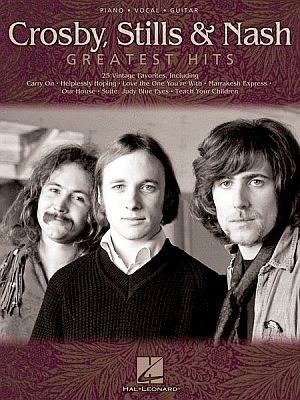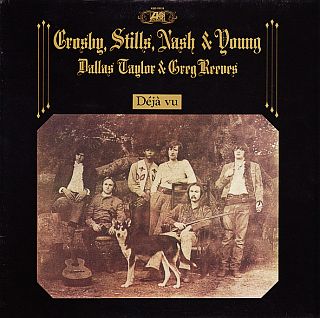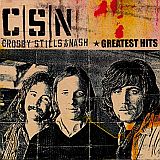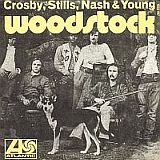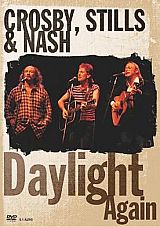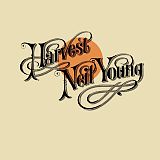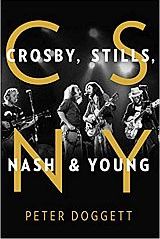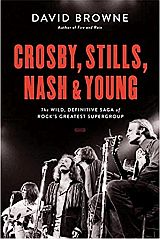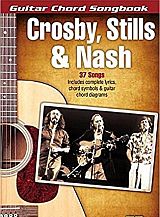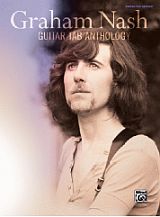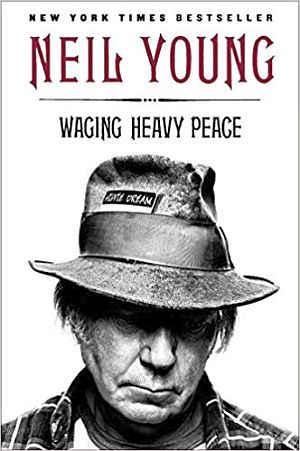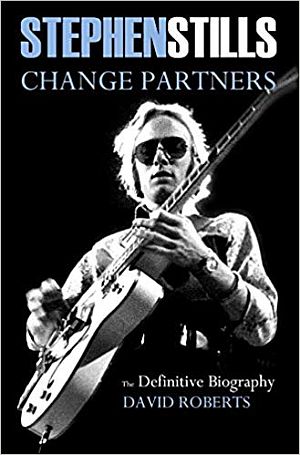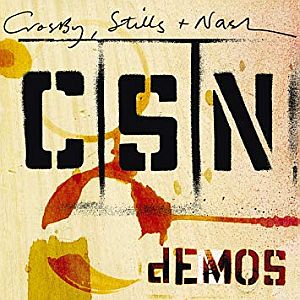In late May 1969, an album of folk-rock music with some stunningly beautiful songs was issued by a group named Crosby, Stills and Nash. It was their debut album, simply titled in their last names, Crosby, Stills & Nash. The three musicians, shown below – David Crosby, Graham Nash, and Stephen Stills – had each played previously with other groups. Crosby, with the Byrds, played guitar, sang and wrote songs; Stills, a guitarist, keyboardist, vocalist and songwriter with Buffalo Springfield; and Nash, a guitarist, singer and songwriter with The Hollies – all groups that had made hit songs and albums. By mid-1968, however, these three singer-songwriter-musicians came together forming a new group to make new music. And what good music it was – fashioning a distinctive and beautiful sound, along with a social statement or two as they went.
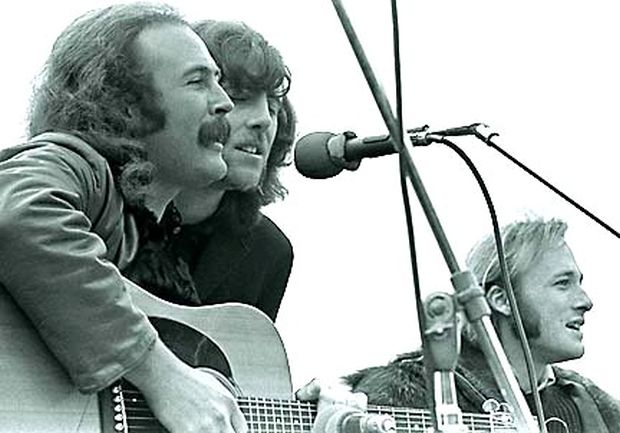
David Crosby, Graham Nash & Stephen Stills at Big Sur Folk Festival, CA, Sept 1969. Photo, Robert Altman.
Legend has it, that at a July 1968 party in Laurel Canyon area of Los Angeles (at either Joni Mitchell or Cass Elliot’s house) Crosby, Stills and Nash tried out a new song written by Stills, “You Don’t Have To Cry,” revealing to themselves and others they had very good vocal chemistry and exceptional harmonies. Before long, excepting a rejection at Apple Records, they were signed by Ahmet Ertegün at Atlantic Records, hiring David Geffen and Elliot Roberts as their management team. Their new album came out in May 1969. And with the help of progressive FM radio in those days, which served up generous portions of new albums over the air, Crosby, Stills & Nash became a wildly popular album. The boys also added to their rising standing by performing at the enormous Woodstock music festival in August 1969, where Neil Young joined the group (later becoming “Crosby, Stills, Nash & Young”). Their performance at Woodstock — then the largest gathering at a rock festival to that date — helped place them among the leading troubadours of the counterculture era.
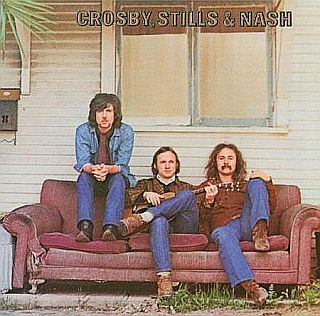
Graham Nash, Stephen Stills, and David Crosby, on the cover of their 1969 album that would help advance the singer-songwriter genre of music through the 1970s. Click for album & digital singles.
“Marrakesh Express” was released first, in July 1969. It’s a song by Graham Nash describing a Moroccan vacation he took in 1966 by train from Casablanca to Marrakesh – a song that was turned down by Nash’s earlier group, the Hollies, as not being commercial enough. Released with “Helplessly Hoping” on the B side, another song from the CSN album, “Marrakesh Express” would rise to No. 28 on the Billboard pop chart by August 23rd, 1969.
“Suite: Judy Blue Eyes” is a song about Stephen Still’s former girl friend, folk singer Judy Collins. It’s the opening song on the album and was released as a single in September 1969 with “Long Time Gone” on the B side. It peaked at No. 21 on the Billboard Hot 100 chart by December 6, 1969 and also rose to No. 11 in Canada. In 2004, Rolling Stone ranked “Suite: Judy Blue Eyes” at No. 418 on its list of the 500 Greatest Songs of All Time. It was also included in the Rock and Roll Hall of Fame’s “500 Songs That Shaped Rock & Roll.”
On the success of their break-out album, Crosby, Stills and Nash won a 1970 Grammy for Best New Artist. The album would continue to be a best seller in later years, earning a RIAA triple platinum certification in 1999 and quadruple platinum certification in 2001.
In one sense, the album was ground-breaking; its music in perfect step with the times. It set a new tone and would prove to be very influential in advancing the singer-songwriter movement of that era, and helped define a kind of “California” or “soft rock” sound that rose to prominence through the 1970s with groups and solo performers such as The Eagles, Jackson Browne, Joni Mitchell, and others. In 2003, Rolling Stone ranked Crosby Stills & Nash at No. 262 on their list of the 500 greatest albums of all time. In addition to its vinyl edition of 1969, it has been issued on compact disc three times: the mid-1980s, again in 1994, and as an expanded edition in 2006. Worldwide is has sold in excess of 6.5 million copies.
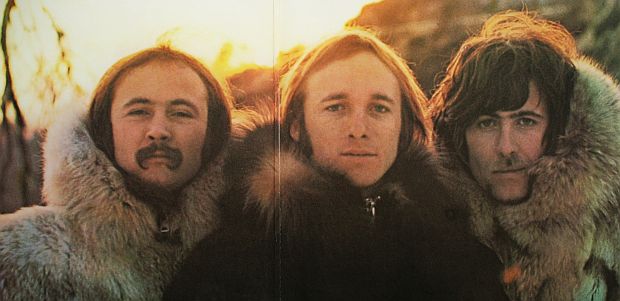
1969. The original 'Crosby, Stills & Nash' vinyl LP album was released in a gatefold-type record sleeve that included the above photo of the three musicians in large fur parkas shot against a sunset background in Big Bear, California. photo, Henry Diltz.
Although the album’s two pop hits, “Marrakesh Express” and “Suite: Judy Blue Eyes” are notable and worthy songs, there are other songs on the album that are arguably better – more beautifully written and performed, more entrancing, more melodic. Among two of these, for example, are “Guinevere” and “Lady of the Island” (“Guinevere” was initially spelled with two “n’s,” later corrected).
|
“Guinevere” Guinevere had green eyes Peacocks wandered aimlessly Guinevere drew pentagrams As she turns her gaze Guinevere had golden hair Yesterday |
“Guinevere”
The lyrics of “Guinevere” appear to be patterned, in part, after Queen Guinevere of King Arthur/Knights-of-the-Roundtable lore, using a Sir Lancelot-type perspective (who had an affair with the queen). However, Crosby has also explained the song has relevance to loves in his own life. Guinevere in the song is clearly the object of the singer’s affection.
According to a Rolling Stone interview with Crosby: “That is a very unusual song, it’s in a very strange tuning with strange time signatures. It’s about three women that I loved. One of who was Christine Hinton, the girl who got killed [in an auto accident] who was my girlfriend, and one of who was Joni Mitchell, and the other one is somebody that I can’t tell. It might be my best song.” Elsewhere, Crosby has said of the song, “It’s three women – three verses, three different women…” – one of whom he promised he wouldn’t reveal.
Music Player
“Guinevere”-4:40
Crosby, Stills & Nash
1969
Guinevere, in the song, provides glimpses of various behaviors and personality traits. The song also deals with the importance of freedom, with Guinevere described longingly by the male narrator as an inspiring beauty, but also as a free spirit, never quite attainable. “Why can’t she see me,” he asks as one point. And later, recalling a time “when we’d ride…down by the bay.” But in the end, it seems, free spirit prevails, with narrator accepting.
The music, in any case is, as one writer put it, “mesmerizingly beautiful,” and fans of this song have not been bashful about singing its praises.
Some posted comments reacting to one YouTube airing of the song a few years ago are indicative of the impressions this song has left on many listeners:
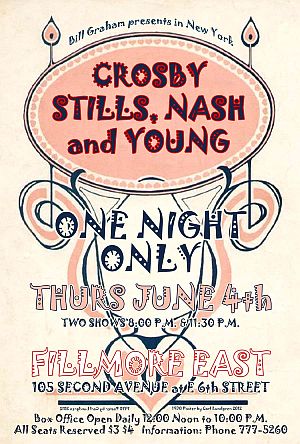 Poster for a Crosby, Stills, Nash & Young concert at New York’s Fillmore East, June 4, 1970. |
Judith Petree: “I still think this is one of the most beautiful songs ever recorded.”
Guitar BS: “This song is so beautiful and haunting. The feeling described in this song doesn’t seem to exist in the 21st century. I dunno, I could be wrong but don’t think so.”
Burt472: “One of the most beautiful songs of the last 2,500 years.”
Limestonegoth: “I wore this album out on vinyl, mostly listening to this song over and over.”
Comer: “Is there any way to describe this song? I consider this one of the most perfect songs ever written. Nothing compares to it.”
Mike Kenwright: “One of the greatest songs ever recorded, I was around 23 when I first herd this track and it always makes my hair on my neck stand on end. The whole album is superb, but this track stands out from the others.”
Adrienne Spy: “Still has the magic. This song will never age.”
Kealani: “Perfection. And no other song is anything like it. Crosby totally knocked it out of the ballpark with this one.”
Thundergod129-7307: “Call me a purist but this is the definitive version of this great ballad. Just David and Graham and a guitar. Pure Bliss…”
Mtjgw: “This song from 1969 is as timeless as they come. Was 11 then and now at 55, the full power of this piece resonates with me every time I hear it. I’m not sure music can ever be better than this as it truly sets the ‘Gold Standard!’.”
TheDocrock100 says, “I constantly hit replay when I get this song on Pandora. Amazing harmony. Timeless.”
Robert Scott adds: “…Always the song I need to hear when I haven’t listened to them for a while.”
Crosby’s skills in writing and arranging “Guinevere” have been praised by Lindsay Planer in one review of the song at AllMusic.com, as follows below:
“Although David Crosby’s contributions to the Byrds had hinted at the depth of his capacity as a singer/songwriter, it would take the calibre of material such as “Guinevere” to reveal his prowess as a true craftsman. This ballad musically spotlights Crosby’s intricate and highly inventive open chord structures. He possesses an uncanny sense of harmonics, which can be likened to that of Brian Wilson or, perhaps more aptly, jazz icon Thelonious Monk. “Guinevere” is likewise structurally designed to augment and support the equally complex vocal harmonies from he and Graham Nash.
“The name “Guinevere” itself instantly conjures up romantic images of knights in shining armour and virtuous maidens fair. Lyrically, Crosby weaves those connotations with his own unique minstrel-like qualities — even incorporating the use of “m’lady” when describing the different muses that influenced his hauntingly beautiful verse.
“The acoustic backdrop is sublime, providing ample space for the crystalline vocals to blend with the sparse instrumentation in an organic way. It also allows Crosby to demonstrate his amazing jazz influenced guitar playing.”
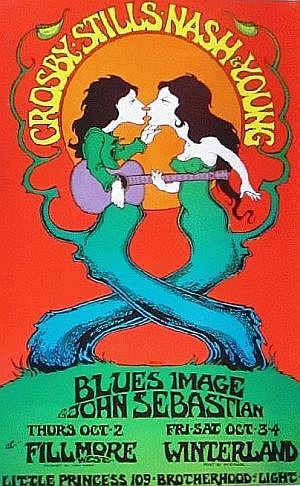
Poster with Crosby, Stills, Nash & Young at top of the bill for October 1969 rock concerts at San Francisco venues.
…What a gorgeous song! … It opens with an almost Sondheim-like chromatic vamp, which turns into a beautiful repeating Dorian-mode figure before the vocals come in. This use of modality is something in common with other music that I like, particularly Reich and early Adams. Do you think David Crosby was sitting around with the score to Ravel’s Mallarmé Songs, turning pages between bong hits?
Then there’s the vocal writing. It’s your standard CSN three-part homophonic harmony at first, which is lovely as usual. But there’s a nifty mixing trick at the end of each verse. The two higher voices are faded in (muted trumpets if I were orchestrating it), holding D and F# (we’re in E dorian, by the way), and they step down in thirds, crossing the remaining voice who has the melody. Some wonderful dissonances result naturally from this, and it’s a terrific effect.
The melody is particularly expressive. It’s rhythmically complex in that it often avoids landing on the beat, which is something I find myself doing a lot in my own music. This is easy for a solo vocalist to pull off — Sinatra is most famous for it — but hats off to these guys for accomplishing it in three parts.
For those listening to this tune with a musical ear, Kaulkin advises: “…Stick with it until the end to hear those descending parallel thirds.”
|
“Lady of the Island” Holding you close undisturbed The brownness of your body Letting myself wander through Wrapped around each other |
Another noteworthy song on the Crosby, Stills & Nash album is “Lady of the Island,” a folk song written by Graham Nash. It is the second track on side two of the original edition of the Crosby, Stills & Nash album.
Like “Guinevere,” this song is also a love song, in this case taking its inspiration from fellow folk musician Joni Mitchell, with whom Nash was romantically involved at the time. The lyrics describe the narrator’s impressions and feelings over the course of one or more intimate engagements between he and his lover.
Music Player
“Lady of the Island”-2:39
Crosby, Stills & Nash
1969
Nash had come up with the melody/music for this song when he was with the Hollies sometime in 1968, but the lyrics weren’t quite there yet. They came later after he began working with Crosby and Stills.
“When I came over to America and I started working with David and Stephen and Neil [Young] and Joni [Mitchell],” explained Nash in a later interview, “I noticed what words they were putting to their melodies and I realized that I would have to get serious about songwriting. I knew I could write melodies, but it was only after I came to America that I really got into changing the way I wrote songs.”
One listener at a YouTube posting of “Lady of the Island” using the name “Charleybones,” noted: “Nash and Crosby make a perfect vocal blend in this song. The sensitivity of Nash’s voice singing the words and melody, with Crosby singing harmony notes that perfectly flow around Nash’s voice. These two were always special together, and Stills simply added the bottom of the three- part harmony and the musicianship to help the other two flush out the instrumental side of their songs in order to produce them on record and in concert. This first CSN album was truly phenomenal….”
“Wooden Ships”
A third song from the Crosby, Stills & Nash album worth mentioning here is “Wooden Ships,” which is the first track on side two of the original album. It was written and composed in 1968 in Fort Lauderdale, Florida, on a boat owned by Crosby. The song was written by David Crosby, Stephen Stills, and Paul Kantner of the Jefferson Airplane, who also recorded a version of the song around the same time. Crosby composed the music, while Kantner and Stills wrote most of the lyrics.
|
“Wooden Ships” If you smile at me, I will understand I can see by your coat, my friend Say, can I have some of your purple berries? Wooden ships on the water, Horror grips us as we watch you die Go, take your sister then, by the hand And it’s a fair wind blowin’ warm |
The song came during the social upheavals of the late 1960s, and at the height of the Vietnam War. Bob Dylan by then had written several songs with anti-war sentiment, and his “A Hard Rain’s a Gonna Fall” was being heard in 1962 around the time of the Cuban Missile Crisis. Barry McGuire’s “Eve of Destruction” came out in 1965. “Wooden Ships” was also aimed at the Cold War clench between the U.S. and Soviet Union and their nuclear arsenals – but in this case, what might happen in the aftermath of a nuclear exchange.
Music Player
“Wooden Ships”-5:28
Crosby, Stills & Nash
1969
The song opens with a series of innocent-sounding guitar picks, landing on a loud and full guitar power riff, sounding at first confrontational and defiant, but then settling into a quieter story mode.
The lyrics depict the horrors of a post-nuclear war landscape. A man from one side stumbles upon another survivor, hoping for a smile as a sign of trust. He can tell by this survivor’s coat, he’s “from the other side.” Then he asks, perhaps with a shred of sarcasm, “Can you tell me, please, who won?”
The conversation then moves on to their survival and the sharing of “purple berries,” which appear safe; “haven’t got sick once” (re: nuclear fallout).
The narrative then turns to wooden ships on the water, those on board, and a sighting of “silver people on the shoreline,” who David Crosby has described as “guys in radiation suits” — authorities scouring the devastation, perhaps, or other survivors protecting themselves from fallout? In any case, those on the ships are “let be” by those on the shoreline.
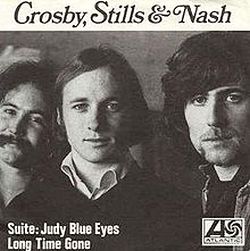
Record sleeve for single release of "Suite: Judy Blue Eyes" and "Long Time Gone". Click for digital.
In the presumed departure of the ships then escaping the devastation, those on board look back in horror at those remaining, feeling helpless, “as all human feelings die.” Those aboard the ship are heading “away from this foreign land” – someplace unnamed, but “far away, where we might laugh again,” adding, “we are leaving, you don’t need us.”
For some listeners in that late 1960s early 1970s period, this music and verse no doubt resonated metaphorically regarding the tumult of those times. Some were then opting out of mainstream culture, seeking new values and alternative lifestyles. The year 1968, for example, from top to bottom was truly annus horribilis in the U.S. in terms of the Vietnam War, the assassinations of Martin Luther King and Robert Kennedy, presidential election tumult, as well as convulsive events abroad.
The Crosby, Stills & Nash album of 1969 also included “Long Time Gone,” a David Crosby song reacting to the July 1968 assassination of Robert Kennedy. And in May 1970, Neil Young was then with the group, and he wrote the CSN&Y protest song, “Ohio,” reacting to the National Guard shooting of student anti-war protesters at Kent State University (see separate story, “Four Dead in O-H-I-O.”). Other songs on the Crosby, Stills & Nash album of 1969 include: “You Don’t Have to Cry”( Stills), “Pre-Road Downs” (Nash), “Helplessly Hoping” (Stills), and “49 Bye-Byes” (Stills).
Déjà Vu & Beyond
Close on the heels of their success with the Crosby, Stills & Nash debut album, the group – now with Neil Young aboard – turned out another album titled Déjà Vu. It was released in March 1970 and rose briefly to No. 1 on the Billboard album chart. It also generated three Top 40 singles: “Woodstock” (written by Joni Mitchell), “Teach Your Children”, and “Our House.”
Déjà Vu would become a monster hit album, selling over 14.3 million copies worldwide. In 2003 it would be ranked at No.148 on Rolling Stone‘s list of the 500 greatest albums of all time.
Crosby, Stills, Nash, and Young, however, had their internal squabbles and artistic differences, and not long after a summer tour in 1970, they had an acrimonious parting of the ways. It would be the first of many such splits. They would break up and reform several times over the next few decades, sometimes with and without Neil Young. They split off into twosomes and solo acts (separate solo albums were issued by each member in 1970-71) and they would hold a number of reunion tours of one kind or another. Yet, they would continue to have a loyal fan base, as their touring and subsequent album sales would make clear. (Note: most album, record, and book images displayed in this story link to Amazon.com pages for those items. Click on images to go to those pages).
Four Way Street, a live double album issued after their first breakup in 1970, became another No. 1 hit (8.7 million worldwide). In 1974, they re-formed for a summer stadium tour, but did not cut a new record. Still, a compilation album was released – So Far – and it too became a No. 1 album, their third straight (10.2 million worldwide).
In 1977, Crosby Stills & Nash re-formed without Young for the album CSN, another giant hit (6.8 million worldwide). They followed that album in 1982 with Daylight Again (2.4 million worldwide). By the mid-1980s, however, David Crosby was in the throes of drug addiction and some legal problems, landing in jail during 1985-1986. But he cleaned up his act and returned to the music scene.
In 1988, CS&N along with Young this time, reunited for what would become only their second studio album, American Dream (1.8 million worldwide). Two years later, CS&N followed with Live It Up, which was not a commercial success, though the trio remained a popular live act. CS&N embarked on a 25th anniversary tour in the summer of 1994 and released a new album, After the Storm (200,000 worldwide).
The trio reunited with Young once again for 1999’s Looking Forward (600,000 worldwide), followed in 2000 by their CSN&Y2K tour. A decade or so later, CSN 2012, a DVD/CD set, filmed and recorded during a 2012 tour, was released that same year. As of early 2017, there appeared to be the possibility that Crosby, Stills, Nash and Young were at least open to the idea of reforming yet again. In any case, they have certainly made their mark musically over the last 50 years or more.
Lauded for their lasting influence on U.S. music and culture, both for kicking off the singer-songwriter movement that soared throughout the 1970s, and their sterling, indelible harmonies, Crosby, Stills & Nash were inducted into the Rock and Roll Hall of Fame in 1997. All three members of the group were also inducted for their work in other groups – Crosby for the Byrds, Stills for Buffalo Springfield, and Nash for the Hollies. Neil Young, meanwhile, with an amazing body of work on his own and with other groups, has also been inducted as a solo artist and as a member of Buffalo Springfield.
There is a lot more detail on the history and biography of Crosby, Stills, Nash and Young – both together and as solo artists. Some of this history can be found at any number of on-line sources and websites, as well as a number of books, some of which are listed here at left or below in “Sources”.
See also at this website, “Joni’s Music, 1962-2000s”, a profile of Joni Mitchell’s career, with song samples, album history, travels, songwriting, and her time with Graham Nash. “Four Dead in O-hi-o, 1970,” profiles the Kent State shootings and the genesis and reception of the CSN&Y song, “Ohio.” Additional stories on music can be found at the “Annals of Music” category page. Thanks for visiting – and if you like what find here, please make a donation to help support the research and writing at this website. Thank you. – Jack Doyle
|
Please Support Thank You |
____________________________________
Date Posted: 18 November 2018
Last Update: 21 January 2023
Comments to: jdoyle@pophistorydig.com
Article Citation:
Jack Doyle, “Crosby, Stills & Nash: 1969 & Beyond,”
PopHistoryDig.com, November 18, 2018.
____________________________________
Sources, Links & Additional Information
“Crosby, Stills, Nash and Young,” in Holly George-Warren and Patricia Romanowski (eds), The Rolling Stone Encyclopedia of Rock & Roll, Rolling Stone Press, New York, 3rd Edition, 2001, pp. 224-225.
“Crosby, Stills & Nash” (biography & induction page), RockHall.com, 1997.
“Crosby, Stills, Nash & Young,” Wikipedia.org.
Jason Ankeny, “Crosby, Stills & Nash (album),” AllMusic,com.
Lindsay Planer, Song Review, “Guinnevere,” AllMusic.com.
Lee Zimmerman, “The 13 Best Songs by Crosby, Stills & Nash,” PasteMagazine.com, September 27, 2016.
Andy Greene, “Track by Track: Crosby, Stills & Nash on Their Self-Titled Debut,” Rolling Stone, August 18, 2008.
Scott Mervis, Weekend Editor, “Review: CSNY Concert Rocks in Truly Classic Style,” Pittsburgh Post-Gazette, Monday, March 20, 2000.
“Crosby, Stills & Nash,” Apple Music Review, iTunes.Apple.com.
“Wooden Ships (1969), Crosby, Stills & Nash,” SongMango.com.
“The Story Behind ‘Wooden Ships’,” The Hangar (Jefferson Airplane), Archived on the WayBack Machine (internet archive), Novem-ber 16, 2012.
“Wooden Ships,” Wikipedia.org.
Lindsay Planer, Song Review, “Wooden Ships, Crosby, Stills & Nash,” AllMusic.com.
“David Crosby,” Wikipedia,org.
David Crosby, Official Website.
“Stephen Stills,” Wikipedia,org.
Stephen Stills, Official Website.
“Graham Nash,” Wikipedia,org.
Graham Nash, Official Website.
“Neil Young,” Wikipedia,org.
Neil Young Website/Archives.
Jordan Runtagh, “Graham Nash Tells the Wild Tales Behind His Most Enduring Songs,” People.com, June 29, 2018.
“Crosby, Stills, Nash & Young (page 2),” UnMask.us.
“Top 100 ’60s Rock Albums” (page down on site), UltimateClassicRock.com.
Rick Moore, “Crosby, Stills & Nash: Wooden Ships; Jefferson Airplane Recorded Their Own Version of The Song for Their Controversial Fifth Album, Volunteers,” AmericanSong-writer.com, January 31, 2016.
“Déjà Vu (Crosby, Stills, Nash & Young album),” Wikipedia.org.
Dave Lewis, “The 10 Best Songs By Crosby, Stills, Nash & Young,” LouderSound.com, August 15, 2016.
Patrick Lyons, “The 10 Best Crosby, Stills And/Or Nash Albums To Own On Vinyl,” VinylMePlease.com, March 9th 2018.
Richard Buskin, “Crosby, Stills & Nash: ‘Suite: Judy Blue Eyes’ | Classic Tracks, Producers: David Crosby, Stephen Stills, Graham Nash; Engineer: Bill Halverson,” SoundOnSound .com, August 2010.
______________________________
